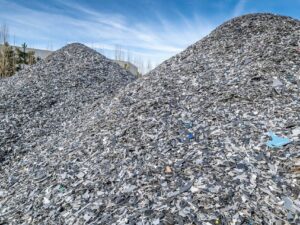Powerhouse Museum presents Sydney’s Science Festival between 11-20 August in a programme that explores sensory themes such as sound sight and touch. This year’s festival theme – Trace – explores the marks we leave on our environment, alongside how scientists strive to understand the sources and effects of different phenomena. In a mesmerising experience that engages audiences with the climate crisis, Mexican Canadian artist Rafael Lozano-Hemmer (b. 1967) premieres his exhibition Atmospheric Memory.
Lozano-Hemmer, a media-artist who combines architecture and performance, first represented Mexico at Venice Biennale in 2007 and since has been awarded two BAFTAs for Interactive Art. Best known for works such as Pulse Index (2011), he focuses on transforming social environments with a range of technologies. The large-scale installation, having shown at the Hirsshhorn Museum, Washington D.C. (2018), Smart Museum of Art, Chicago (2021), and Epsoo Museum of Modern Art, Finland (2022), visualises the fingerprints and heart rates of over 3,911 users across a curved projection that fills a gallery wall. Each new participant thus erases the data of the last one in the sequence. Other projects also include Surface Tension (2016), where an image of giant eye follows the observer with an Orwellian precision, and Metronomos (2019), a kinetic presentation that moves according to the changes of human rights violations.

The artist said in an interview with Aesthetica in 2019, “Do we want to live in society where everything is remembered? 180 years after Babbage, we find that the digital atmosphere is completing his dream. Today, our phones and our cities are tracking us – everything is stored. Atmospheric Memory moves from a thoughtful, romantic approach – with one hour of projections and phantasmagorias – to illustrating the state of surveillance. We have cameras trained on the public with face recognition, tracking their position in relation to others. There is moment of realisation that these mechanisms are in place everywhere.”
Loranzo-Hemmer’s current display, Atmospheric Memory, was commissioned by and debuted at Manchester International Festival in 2019. The mesmerising exhibition explores inventor and mechanical engineer Charles Babbage’s proposal that the atmosphere is a “vast library” recording everything we say. This is realised through cutting-edge technology and interactive pieces that transform vibrations in the atmosphere into something visitors can see, hear and touch. Works include a voice-controlled fountain that turns speech into water vapour and a corridor of 3,000 channels of natural and unnatural sounds from 200 types of insects and 300 types of birds. Also present is the world’s first 3D-printed speech bubble, lead by a laser tomograph that captures air as it exits the mouth, converting the shape of words into sculptures.


Hemmer says, “When we talk about technology, we often speak about how it is empowering us, giving us agency. In this project we take on a more critical view, exploring surveillance and climate change. Fast forward 180 years from Babbage, what is “Atmospheric Memory?” The answer is the accumulation of carbon dioxide. At the time of his writings, there were 237 parts per million of CO2. Today we have 440 parts per million in the air, which is way past the 350 that most scientists recommend as safe. This number is increasing – 63% of this accumulation has happening in the last 20 years. We can think of carbon dioxide as the memory of industrialisation. The installation visualises the problem of climate change. This is the atmospheric memory we need to pay most attention to, as the defining moment of our time.”
The exhibition also includes 50 objects from the museum’s permanent collection. One of the key highlights is Babbage’s Difference Engine No 1, a general-purpose mechanical calculating machine that anticipated the structure of the modern computer. Also incorporated is a tinfoil phonograph, a rare example of one of the earliest sound recording and playback machines, invented by Thomas Edison in 1877, and an Aneroid barometer used at Sydney Observatory in the 1800s to measure pressure and make weather forecasts.

Powerhouse Chief Executive Lisa Havilah notes, “The Powerhouse holds Australia’s most significant collection of science, technological and design. The development of Atmospheric Memory at the Powerhouse is a collaborative process between the artist and museum, and we are excited to share this incredible experience with our visitors.” This exhibition joins other environmentally-conscious site-specific displays such as Southbank Centre’s Dear Earth, hosting a large-scale media screen made with recycled bottles and Ai Weiwei’s Making Sense at The Design Museum, that criticises the impact of deforestation. The value of art, activism and digital mediums now, more than ever, acts as a means of change. This installation reflects our current ecological crisis, as it recognises the effects of rapid industrialisation. Lozano-Hemmer stated, “When people come out, I hope they feel like the atmosphere is materialised – that it’s not neutral, it’s the battleground for the survival of the species.”
Powerhouse Ultimo: Atmospheric Memory | 11-20 August
Image Credits:
1. Atmospheric Memory by Rafael Lozano-Hemmer, Cloud Display 9 (2019) at UNC2021 photo by Olivier Groulx
2. Atmospheric Memory by Rafael Lozano-Hemmer, Cloud Display 4 Love, MIF19, copyright Mariana Yåñez
3. Atmospheric Memory by Rafael Lozano-Hemmer, Zan Wimberley
4. Atmospheric Memory by Rafael Lozano-Hemmer, Zan Wimberley
5. Atmospheric Memory by Rafael Lozano-Hemmer, Text Stream (2019), at UNC2021, photo by Olivier Groulx





